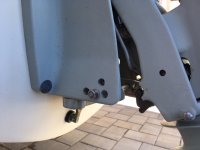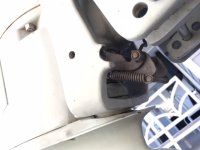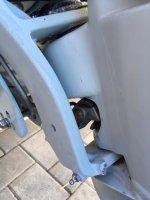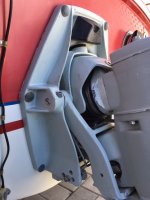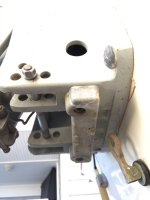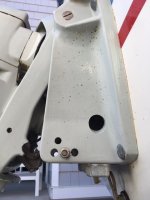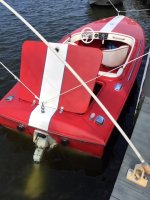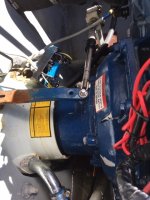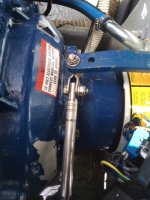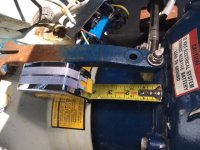Hi all. I've been following the forum for some time now to glean more info on my VP AQ280 drive and related service requirements. I'm astounded at the level of expertise found here. I recently joined as a member as I could really use some help on this issue and I'm hoping some of the experts like Rick will chime in . (Please excuse me if I get some of the nomenclature wrong. The little experience I've had with drives in the past was with MerCruiser this is the first VP I've owned or worked on.
For some background this is a 1978 Donzi 18 ft (2+3) with a Ford 351W Commander/ AQ280 package. When I first got the boat I replaced the U-Joints & bellows by removing the upper drive gear unit . While working on it I happened to notice the lift's round foot (pressure plate) was contacting the thrust sleeve/release rod at a location that was far off center. I thought maybe that was normal and it centered itself better as the drive lifted and since it all worked fine for most of the season I didn't give it much thought. Now however I have run into a serious problem. While running in shallow water last weekend I could feel the boat running aground and tried to operate the lift to no avail. Would not move up or down. When I pulled the boat out on the ramp I realized the latch was not releasing even though the drive was all the way down. I managed to release it using a screwdriver and after lifting slightly I could see where the thrust sleeve and ridden completely off the pressure plate and was trapped behind it. Further examination showed the lift had a bent shaft and worse now had developed a crack in the housing (transom plate? ) where the lift shaft exits. (see photo 4)
I managed to unscrew the distorted pressure pad and remove the lift mechanism. The end of the housing where the sealing nut threads on is cracked off. I have not completely disassembled it yet but at this point I'm looking at a new housing, new shaft and pressure plate at the very minimum. I can deal with all that. My biggest concern though is the crack in the transom plate. This boat is all original and in beautiful condition so the prospect of pulling the motor or having to tear all the running gear off the transom to fix that crack has me freaking out a bit.
If I clear enough room by removing the upper drive/ helmet, etc. I think it would be accessible enough for a good welder to reach in and tig the crack shut. Does this sound like a workable idea ? If so should I attempt to push the crack closed before welding or fill it in the way it is ? I'm guessing if I don't push it back the O-ring on the sealing nut may not seal as the bottom of the bore will no longer be perfectly round.
Looking forward to your replies and suggestions.
Gerry
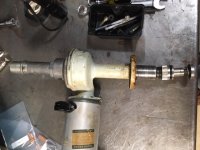
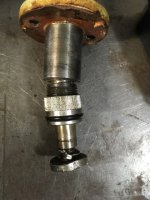
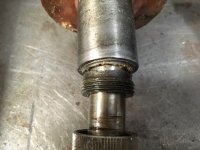
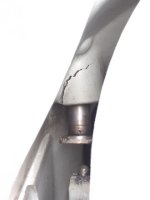
For some background this is a 1978 Donzi 18 ft (2+3) with a Ford 351W Commander/ AQ280 package. When I first got the boat I replaced the U-Joints & bellows by removing the upper drive gear unit . While working on it I happened to notice the lift's round foot (pressure plate) was contacting the thrust sleeve/release rod at a location that was far off center. I thought maybe that was normal and it centered itself better as the drive lifted and since it all worked fine for most of the season I didn't give it much thought. Now however I have run into a serious problem. While running in shallow water last weekend I could feel the boat running aground and tried to operate the lift to no avail. Would not move up or down. When I pulled the boat out on the ramp I realized the latch was not releasing even though the drive was all the way down. I managed to release it using a screwdriver and after lifting slightly I could see where the thrust sleeve and ridden completely off the pressure plate and was trapped behind it. Further examination showed the lift had a bent shaft and worse now had developed a crack in the housing (transom plate? ) where the lift shaft exits. (see photo 4)
I managed to unscrew the distorted pressure pad and remove the lift mechanism. The end of the housing where the sealing nut threads on is cracked off. I have not completely disassembled it yet but at this point I'm looking at a new housing, new shaft and pressure plate at the very minimum. I can deal with all that. My biggest concern though is the crack in the transom plate. This boat is all original and in beautiful condition so the prospect of pulling the motor or having to tear all the running gear off the transom to fix that crack has me freaking out a bit.
If I clear enough room by removing the upper drive/ helmet, etc. I think it would be accessible enough for a good welder to reach in and tig the crack shut. Does this sound like a workable idea ? If so should I attempt to push the crack closed before welding or fill it in the way it is ? I'm guessing if I don't push it back the O-ring on the sealing nut may not seal as the bottom of the bore will no longer be perfectly round.
Looking forward to your replies and suggestions.
Gerry








